The kitchen is so much more than a room for cooking. In my childhood home, it was the chaotic, flour-dusted heart of Polish pierogi-making sessions with my Babcia, and it was the quiet, fragrant space where my mother would mindfully prepare a single, perfect cup of Chinese tea. The stories, the smells, the steam—it was the center of our cultural world. And yet, the walls were just… beige. It’s a disconnect I’ve seen in countless homes since. We pour our heritage and our memories into our food, but the walls of our kitchens often remain silent witnesses, failing to reflect the vibrant lives lived within them.
For the last decade, I’ve dedicated my work to bridging that exact gap. My own Polish-Chinese background taught me that blending cultures isn’t about compromise; it’s about creating a new, richer harmony. And I’ve found that wallpaper, believe it or not, can be one of the most powerful tools for this. Today’s wallpapers are a world away from the fussy, fragile papers of the past. We’re talking about high-tech materials and patterns that draw from every corner of the globe—from the serene minimalism of the East to the bold maximalism of the West. It’s a canvas for your family’s story in a way that a simple can of paint just can’t be.
This isn’t just a list of 22 pretty pictures. This is a guide to both the soul and the science of choosing the right paper for your kitchen. We’ll get into the nitty-gritty of how patterns can trick the eye, how new materials stand up to the mess and heat of a real, working kitchen, and how to apply them in a way that truly honors the heart of your home. Your journey to a kitchen that feels authentically you starts now.
1. Understanding the Cultural Evolution of Kitchen Wallpaper Benefits
Let’s be honest, the resurgence of kitchen wallpaper isn’t just about pretty patterns. It’s part of a much bigger shift. For a long time, especially in the West, the ideal kitchen was one of almost sterile uniformity. Think mass-produced, “don’t-rock-the-boat” design. But now, we’re finally seeing a collective desire to bring our heritage and our personal stories out of the cupboards and onto the walls. This is more than just decorating. It’s about crafting a space that tells a story, maybe even bridging the gap between your culture and your partner’s, and celebrating the wonderful mess of modern life.
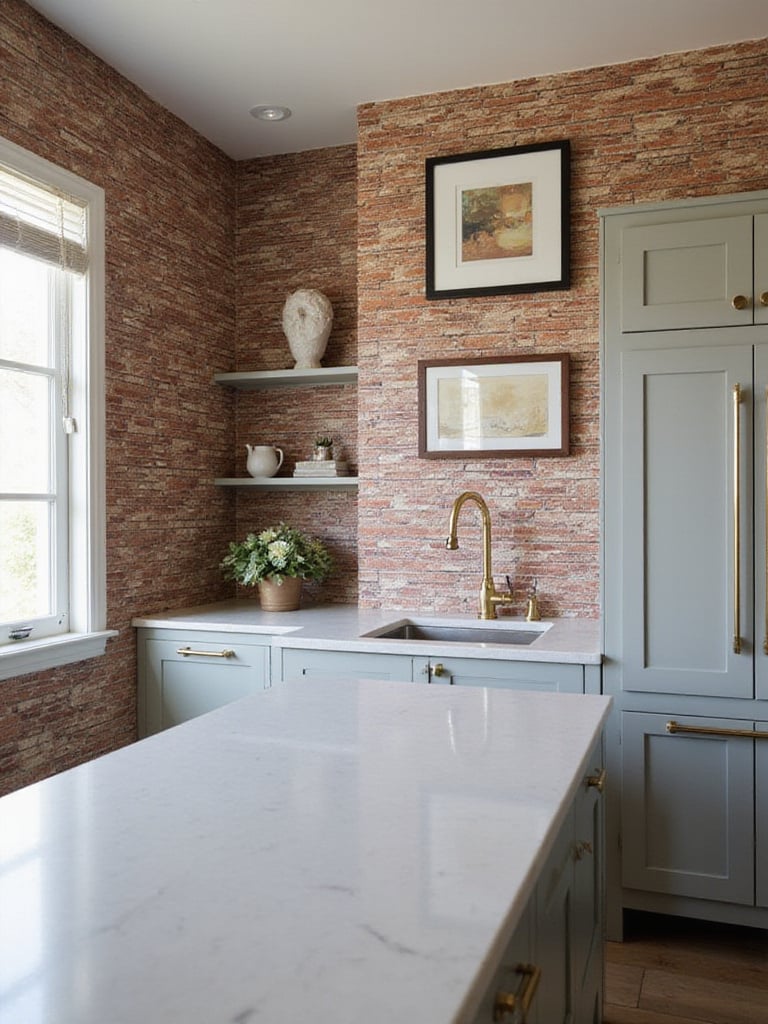
And from a purely practical side, today’s wallpapers are built for that beautiful mess. My clients cook everything—from steamy dim sum and simmering Polish bigos to splattering Italian pasta sauce. These wallpapers can handle it. Advanced vinyls and non-woven fabrics are designed to last 10-15 years, standing up to the kind of humidity and grease that would have destroyed older papers. As one of my go-to installers, Maria Santos, always says, “Modern families cook diverse food. That means diverse challenges—high heat from a wok, steam from a rice cooker. The papers we have now are engineered for this culinary world tour.”
This means the first step isn’t looking at patterns, but at your life. How does your kitchen function during the holidays? What does a typical Tuesday night meal look like? If you do a lot of high-heat cooking or host big family gatherings, you might even look at materials rated for commercial use. Always, always prioritize surfaces you can scrub, especially in areas where your family’s cooking traditions might get a little more expressive than a simple sandwich-making station.
Now, with that practical foundation, we can start thinking about where the aesthetic magic happens. Strategic placement is where we turn that durable material into a meaningful story.
2. Strategic Placement Principles Across Cultural Design Traditions
The art of figuring out where to put wallpaper draws on centuries of global wisdom. It’s a real balancing act. In Eastern design, there’s a deep respect for “visual breathing room”—letting a pattern have its moment without screaming for attention. It’s a conversation between the pattern and the empty space around it. Western traditions, on the other hand, often champion the bold focal point, a single “wow” moment that defines a room. The trick is understanding you don’t have to choose.
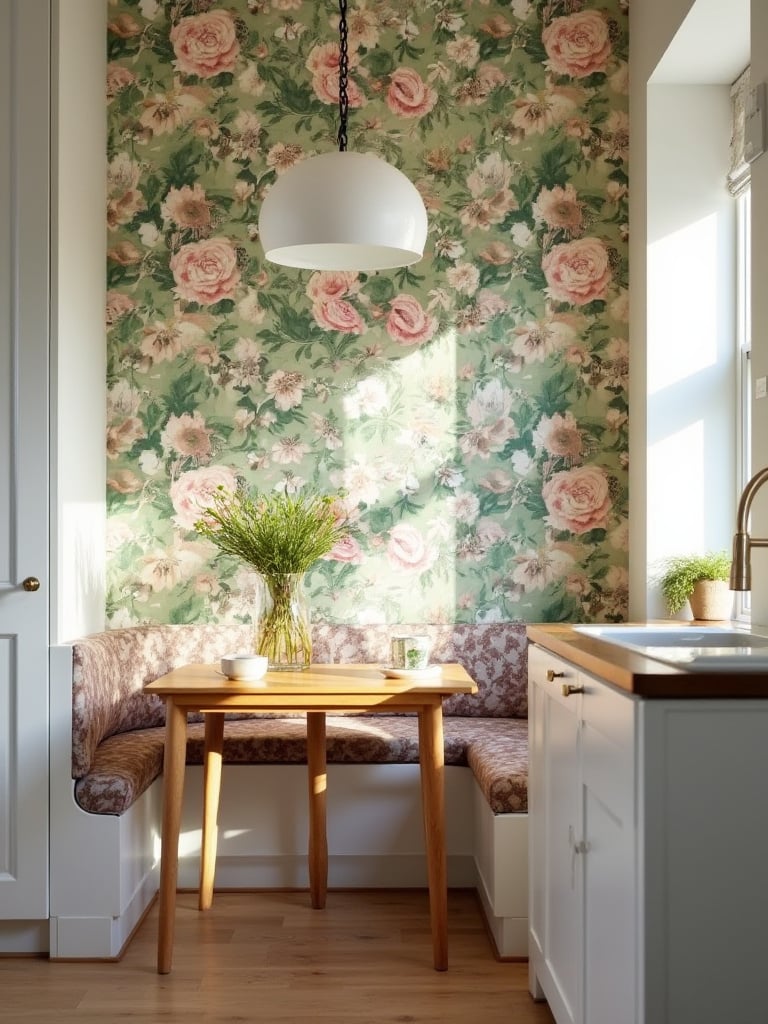
In my work blending these sensibilities, I’ve found the most stunning kitchens often do both. They practice Eastern restraint in one area and embrace Western boldness in another. Imagine a subtle, geometric pattern inspired by Islamic tilework behind your coffee bar—a quiet, intricate moment for your morning ritual. Then, a dramatic, lush botanical, reminiscent of a traditional Chinese silk painting, filling the wall of your breakfast nook. You’re respecting both the need for purpose and the desire for impact. A fellow designer I admire, Chen Wei, talks about enhancing the kitchen’s qi—its life force or energy flow. It’s not just about where your eye goes, but how your body moves and feels in the space.
So, where do you start? Look at your kitchen with fresh eyes. What wall do you see first when you walk in? That might be your focal point. Is there a cozy corner that could become a defined zone with a special pattern? Think about how you cook. Does everyone gather around the island? The wall behind the range is often a prime spot, witnessing everything from quick weeknight stir-fries to slow-simmered weekend stews. Get big samples and tape them up. Watch how the morning light hits them versus the warm glow of evening lamps.
Here are a few starting points:
- Primary Focal Areas: The wall behind the stove, the main wall in a breakfast nook, or the wall that greets guests at the entrance.
- Secondary Accent Zones: This is where the magic gets personal. Think the back of glass-front cabinets, the side of a Kitchen Island, or a surprising pop of pattern inside your pantry.
- Transitional Spaces: In an open-plan home, using wallpaper to define the edge of the kitchen where it meets the dining or living area can be incredibly effective.
Once you have a sense of where, the next crucial question becomes about the what—specifically, how big or small the pattern should be.
3. Pattern Scale Harmony: Balancing Eastern Minimalism with Western Boldness
Pattern scale is a language, and different cultures use it to say very different things. It goes so much deeper than just what looks pretty. Eastern design, for instance, often gravitates toward smaller, intricate patterns. Think of the delicate blossoms on a Japanese kimono or the mesmerizing repetition in Korean celadon pottery. These patterns invite you to come closer, to contemplate. Conversely, Western traditions often lean into big, bold patterns that grab your attention from across the room and make a confident statement. The real artistry in a cross-cultural home is learning how to make these two philosophies sing together.

The key is understanding that pattern size dramatically changes how we perceive a space. I’ve worked in small galley kitchens where a busy, large-scale Western pattern would have felt claustrophobic. But an Eastern-inspired, small-scale design created a feeling of detailed richness, like a little jewel box. On the other hand, a single accent wall with a dramatic, large-scale print can give that same small kitchen incredible depth. For larger kitchens, you have the luxury of layering. You could use a subtle, textured pattern on most walls and then bring in a powerful geometric feature wall. Dr. Sarah Kim, a design anthropologist I follow, puts it perfectly: “Pattern scale functions differently across cultures. What reads as sophisticated restraint in one tradition might feel sparse in another.” The goal is to find a balance that speaks to both sides of your story.
To make this work for you, start by thinking about your own cultural comfort levels. Were you raised in a home with lots of patterns and visual complexity, or one that was more minimalist? There’s no right or wrong answer. Grab samples in different scales—small, medium, and large—and create a mood board. Prop it up in your kitchen and live with it for a few days. See how it feels next to your cabinets, your countertops, your appliances.
This naturally leads us to think about how a new pattern will play with the elements that are already there, which is a delicate dance of its own.
4. Creating Cultural Harmony: Integrating Wallpaper with Existing Kitchen Elements
Bringing a new wallpaper into your kitchen is like introducing a new person into a conversation. You need to make sure it gets along with everyone who’s already there. This gets especially interesting in kitchens that are already a beautiful mix—say, sleek Scandinavian cabinets paired with the warm, rustic wood of a Japanese farmhouse, or modern stainless steel appliances next to the earthy stone of a Mediterranean villa.
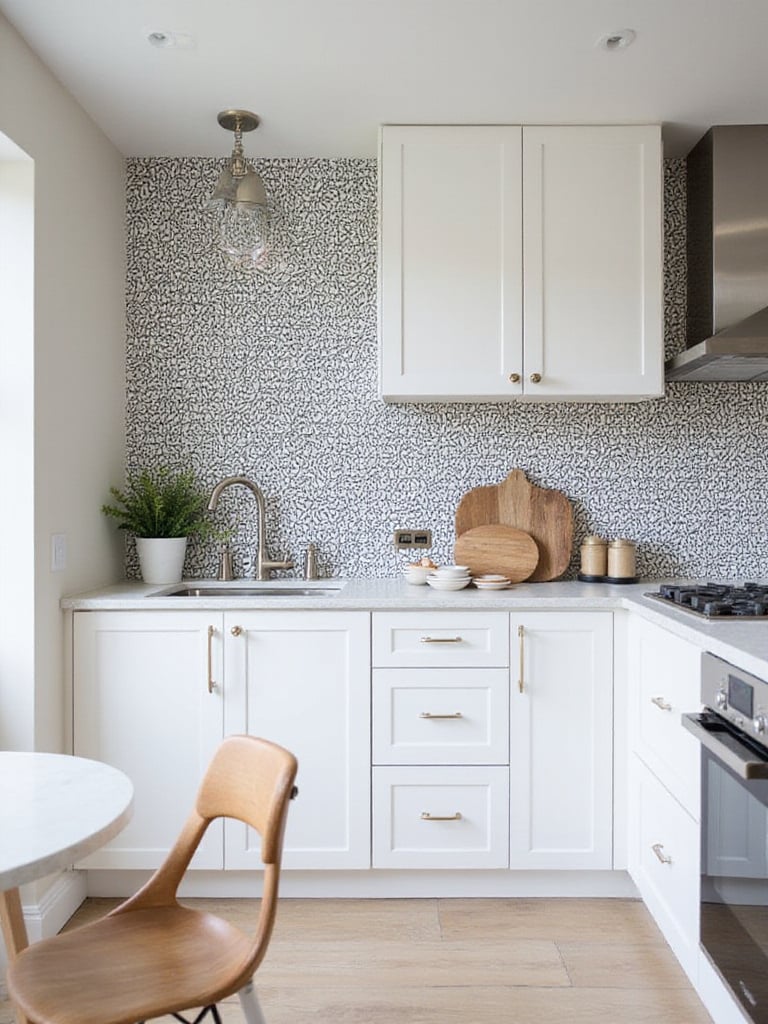
The secret is to first identify the “cultural DNA” that’s already in the room. What stories are your cabinets telling? What about your countertops? Eastern design often favors subtle shifts in tone within a calming palette, while Western styles might use high contrast for drama. If your kitchen has clean, minimalist lines, a wallpaper with the organic curves of Art Nouveau or the sharp angles of the Bauhaus movement could create a fantastic dialogue. If you already have ornate, traditional cabinets, the cool simplicity of a Scandinavian-inspired pattern might be the perfect counterpoint. I often tell my clients to think of the wallpaper as a cultural translator. Its job is to help the different design elements in your kitchen speak the same language, even if they have different accents.
So, get practical. Take photos of your kitchen from every angle. What are the dominant design languages you see? Are there warm or cool undertones in your wood, stone, and metal finishes? Look for a wallpaper that can be a bridge.
Here’s how to think about it:
- Tonal Integration: Find a wallpaper with undertones that match your existing finishes. That warm brass hardware you love will sing next to a paper with golden or ochre threads.
- Textural Balance: If you have a lot of smooth, glossy surfaces (like lacquered cabinets or a polished stone counter), a wallpaper with a subtle texture—like a grasscloth or linen effect—can add incredible warmth and tactile interest.
- Cultural Bridging: This is the most exciting part. Look for patterns that hint at multiple traditions at once. There are geometric designs out there that feel both like Islamic tile and Art Deco glamour, creating an instant fusion.
Of course, all these beautiful ideas need to fit within a real-world budget, which requires its own kind of creative thinking.
5. Smart Budgeting for Culturally Conscious Kitchen Wallpaper Projects
When you’re choosing a wallpaper that carries real cultural meaning, budgeting becomes more than just a numbers game. It’s about investing wisely to honor the story you want to tell. This is different from just picking a pretty pattern off a shelf. Sometimes, the designs that best represent a particular heritage require higher-quality materials or more precise printing to do them justice. The goal is to create a space that feels deeply authentic without causing financial stress.
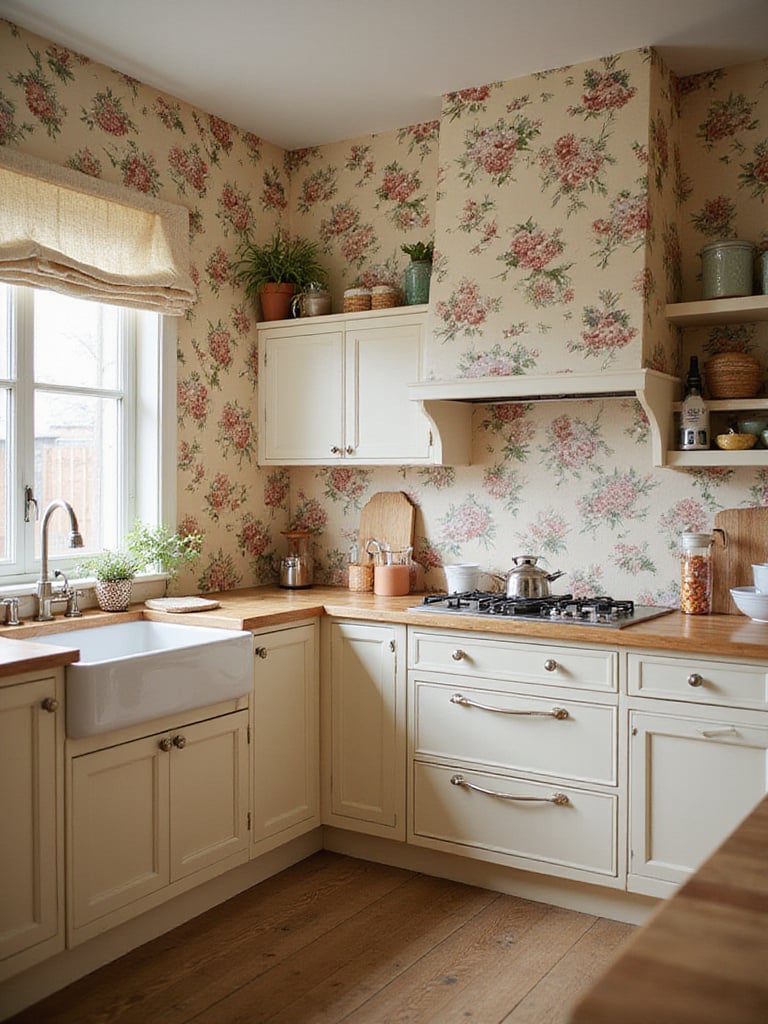
Often, capturing the true spirit of a cultural design means investing in premium materials. Hand-printed papers that show the subtle, perfect imperfections of traditional block printing, or textured grasscloths that evoke a sense of natural, handcrafted quality, will understandably cost more than mass-produced vinyl. But here’s the secret: you don’t need to cover every wall. Strategic placement is your best friend. I often advise clients to invest in that one incredible, hand-printed botanical for a single, high-impact wall, and then use a more affordable, complementary solid color or subtle texture on the other walls. As a colleague of mine, Raj Patel, who specializes in culturally authentic interiors, wisely says, “Authenticity doesn’t always mean expensive. It means knowing which elements are non-negotiable for your story.” Sometimes a well-chosen peel-and-stick that captures the exact color palette of your heritage can be more effective than a pricier paper that misses the mark.
Start by making a list of your priority surfaces. Which wall will have the biggest visual and emotional impact? Allocate the largest chunk of your budget there. Then, do your research. Look for suppliers who specialize in culturally specific patterns—they often offer better value and more authentic designs than big-box stores. And don’t forget installation costs. A complex geometric or a delicate, hand-printed paper might require a pro, so factor that in.
A few budgeting tips:
- Priority Allocation: Plan to spend 60-70% of your wallpaper budget on that primary, high-impact area.
- Material Research: Compare an authentic pattern from a specialized maker with a mainstream “interpretation.” Which one truly captures the spirit you’re after?
- Installation Planning: Get a quote for professional installation, especially for tricky patterns, so there are no surprises.
With a smart budget in place, you can start exploring specific styles. A great place to begin for many contemporary, multicultural homes is the clean and serene world of modern minimalism.
6. Modern Minimalist Fusion: Bridging Eastern Simplicity and Western Functionality
Modern minimalist design is a fantastic starting point for cultural fusion in the kitchen. It’s a style that provides a clean, calm canvas where both Eastern principles of simplicity and Western ideals of functionality can truly shine. This approach draws heavily from the Japanese concept of ma—the profound beauty of negative or “empty” space—while also embracing the efficient, streamlined workflows that are a hallmark of Western kitchen design. The result is a kitchen that feels both tranquil and full of energy, a space that’s as perfect for quiet morning meditation with a cup of tea as it is for the bustling chaos of a family dinner.
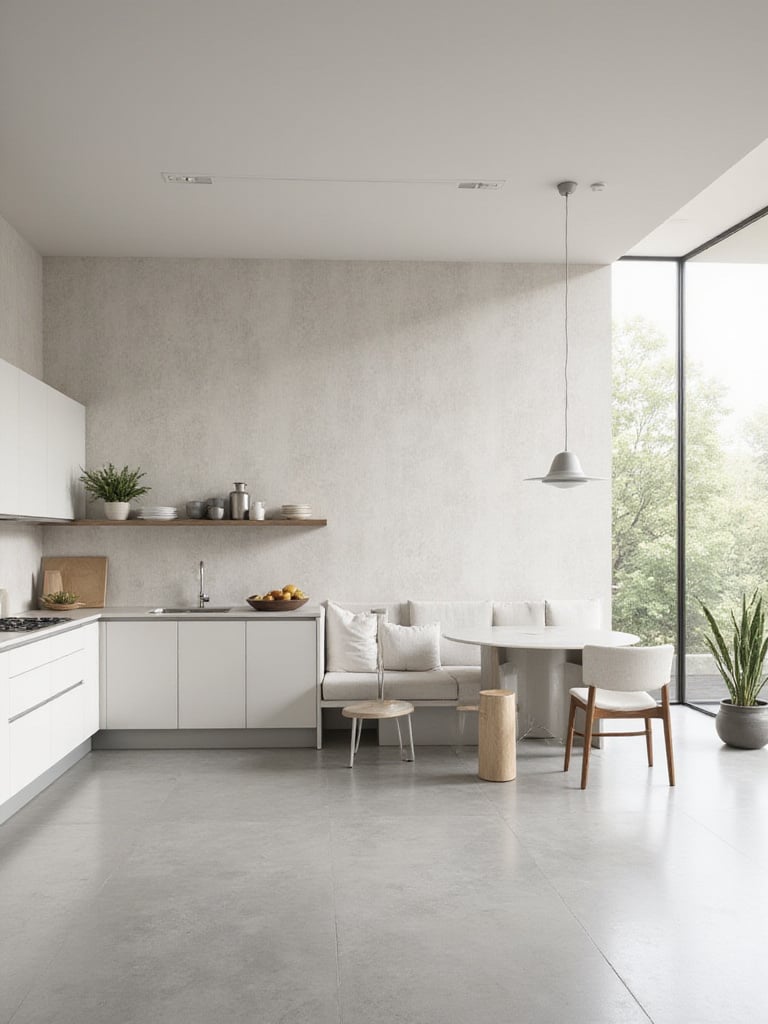
The magic of minimalist wallpaper in a cross-cultural kitchen is its quiet power. It can add texture, depth, and sophistication without shouting over the other cultural elements in the room. Think of subtle textures that evoke natural materials: a paper that mimics the fine weave of linen, touching on both Scandinavian traditions and Japanese paper-making, or a soft concrete effect that nods to both Bauhaus industrialism and contemporary Asian architecture. These wallpapers become a sophisticated backdrop. They allow your treasured cultural artifacts, your colorful cookware, and your unique decorative pieces to take center stage. As design researcher Dr. Anna Larsson puts it, these spaces use wallpaper to create “quiet complexity”—surfaces that slowly reveal their depth rather than demanding attention. This allows your personal and cultural layers to accumulate naturally over time.
When you’re choosing a minimalist wallpaper, the focus shifts from pattern to texture and undertone. Look for papers that have a subtle three-dimensional quality, something that will play with the light as it changes throughout the day. Consider how it will look in both the bright task lighting common in Western kitchens and the warm, low ambient light often favored in Eastern homes.
This focus on subtle, natural textures provides a perfect bridge to our next exploration: the rich and varied world of botanical patterns.
7. Botanical Heritage: Celebrating Global Garden Traditions in Kitchen Design
There is something universally powerful about bringing the natural world indoors. Botanical wallpapers offer a beautiful way to honor our diverse cultural connections to nature, creating kitchens that feel both deeply rooted and globally aware. Every single culture has its own unique way of interpreting plants in art. Think of the perfect, geometric precision of plants in Islamic garden designs, the flowing, romantic chaos of an English cottage garden, the profound symbolism of the cherry blossom in Japanese art, or the vibrant, oversized tropical leaves celebrated in Caribbean design. Choosing a botanical pattern allows you to weave your own heritage into the very fabric of your walls.
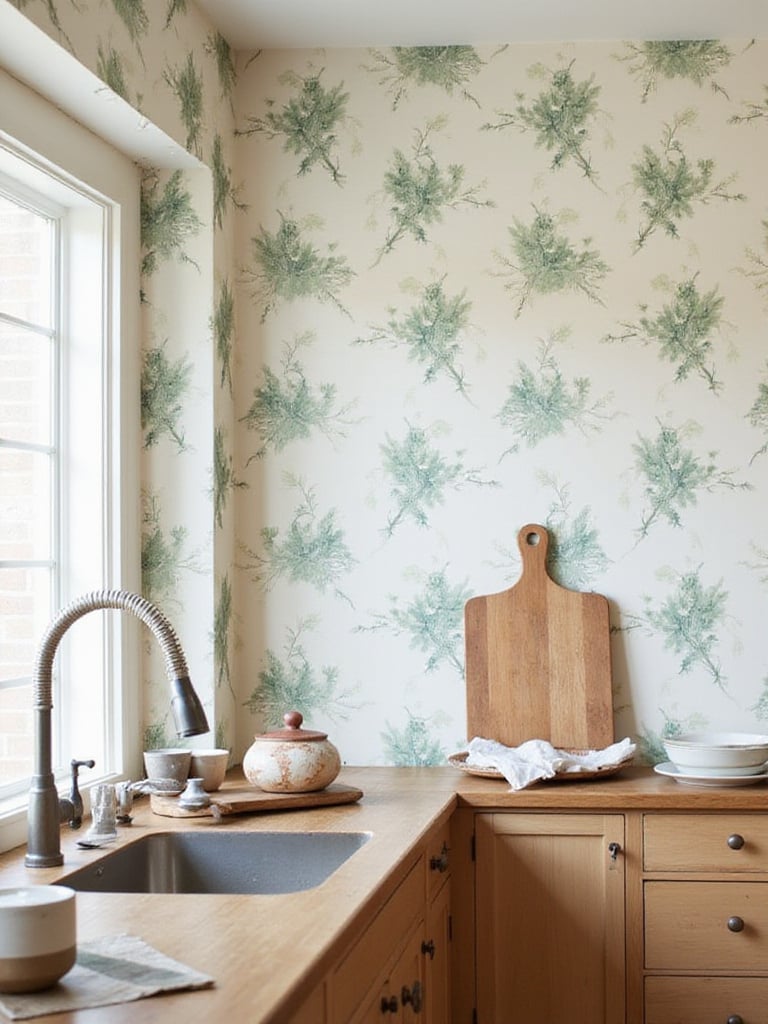
The key to getting this right is to understand the story behind the plants. Don’t just pick a pretty flower. Pick a meaningful one. Maybe it’s a delicate pattern of Mediterranean herbs that reminds you of your grandmother’s cooking. Perhaps it’s bold palm fronds that transport you back to a childhood home in a tropical climate. This is where wallpaper transcends decoration and becomes a daily touchstone to your cultural memory—a connection to the land, the seasons, and the agricultural roots that shaped your family’s history. An ethnobotanist and designer I admire, Dr. Maria Gonzalez, explained it to me this way: “Plants carry cultural memory. When a family chooses a wallpaper with the olive branches of their Mediterranean roots or the bamboo of their Asian heritage, they are creating a daily link to ancestral knowledge and identity.”
To find the right pattern, research the symbolism of different plants. What do they represent in your culture? Consider how a pattern aligns with your kitchen’s use—herb and vegetable motifs are wonderful in cooking zones, while blooming florals can create a joyful atmosphere in a breakfast nook.
Some things to consider:
- Cultural Plant Symbolism: Bamboo for flexibility, olive branches for peace, the lotus for purity—what speaks to your story?
- Seasonal Connections: Choose a pattern that reflects the seasons in your part of the world, or one that honors a seasonal celebration important to your culture.
- Scale Relationships: You can create beautiful visual rhythm by balancing a delicate, small-scale floral with a bolder, large-scale leaf pattern.
From the organic forms of the plant world, we can journey to the structured, mathematical beauty found in geometric traditions.
8. Global Geometric Traditions: From Islamic Patterns to Art Deco Influences
Geometric wallpapers are like a passport through the history of human creativity and intellect. They offer a direct line to the mathematical and artistic traditions that have shaped cultures for centuries. These aren’t just shapes; they are patterns rich with meaning. The endlessly repeating tessellations in Islamic art speak of infinity and the divine. The sharp, clean angles of Art Deco celebrate the dawn of the machine age and a fusion of global influences in the 1920s and 30s. When you understand these deeper contexts, choosing a geometric paper becomes an act of celebrating human ingenuity.

What’s so powerful about geometric patterns in a multicultural kitchen is their ability to act as a bridge. They have a universal language. You could find a wallpaper that blends the mathematical precision of an Islamic pattern with the vibrant, earthy color palette of Mexican Talavera pottery. Or you could discover a design that feels like a conversation between the clean lines of Scandinavian design and the intricate, interwoven lines of Celtic knotwork. These combinations create spaces that feel both globally sophisticated and intensely personal. As art historian Dr. James Morrison once pointed out, “Geometric patterns are perhaps our most universal decorative language. The most exciting designs today are finding ways to let multiple traditions speak at once, creating something entirely new.”
To make a geometric pattern work in your kitchen, you need to understand both its cultural roots and its visual impact. How does the tradition you’re drawn to use color and scale? Is it based on repetition or on creating a single, powerful motif? Research the history that gives the pattern its soul.
From the world of mathematics and line, we turn to the raw, tactile world of material storytelling, where wallpapers can mimic the authentic feel of global building traditions.
9. Authentic Material Stories: Faux Finishes That Honor Global Building Traditions
Faux finish wallpapers have become incredibly sophisticated, offering a stunning way to honor global building traditions without needing a full-scale renovation. These are not the tacky fake-brick papers of the 70s. We’re talking about high-definition papers that can authentically capture the weathered texture of limestone from a Mediterranean villa, the smooth, polished look of Tadelakt plaster from a Moroccan riad, the warm, rough-hewn planks of a Scandinavian farmhouse, or the precise brickwork of an English Tudor home. It’s a way to bring the architectural soul of your heritage into a modern space.
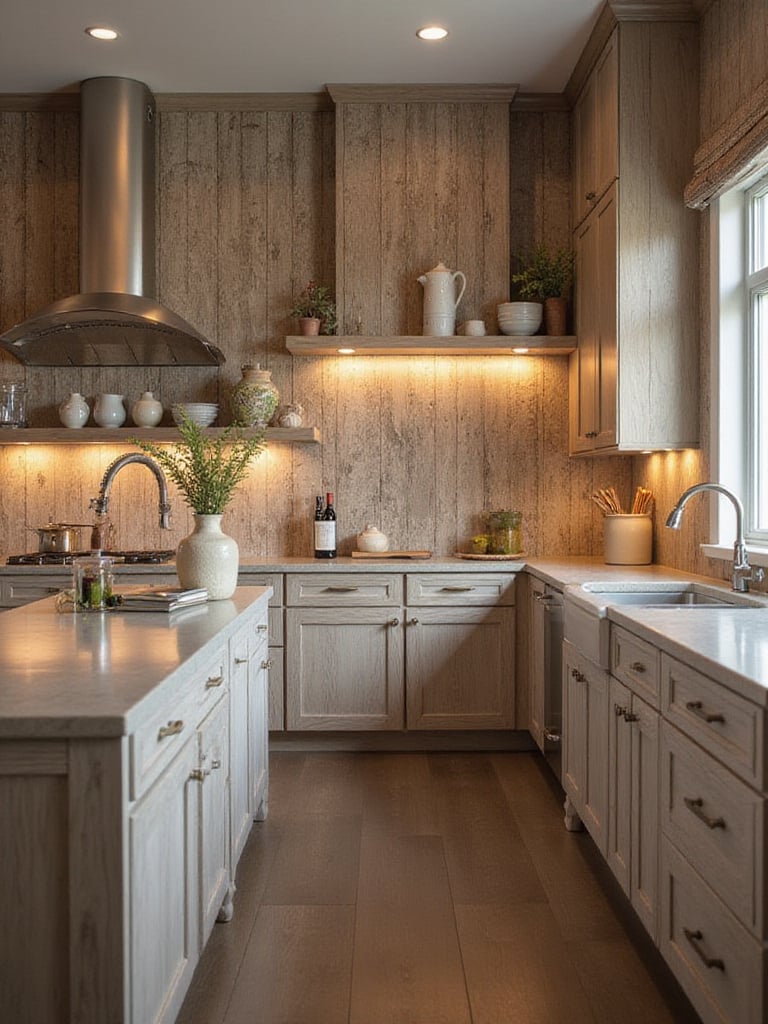
The real power here goes beyond just aesthetics. These material reproductions connect us to the hands, the tools, and the traditions that built our ancestors’ homes. A wallpaper that mimics the stone walls of an Irish cottage or the woven bamboo screens of a Japanese tea house isn’t just a visual trick; it’s a daily, tangible link to a sense of place and identity. The quality has become uncanny. Advanced printing and embossing techniques can now capture not just the look but also the feel of these traditional materials. A master craftsman, Giovanni Rossi, who specializes in historic European building techniques, once told me, “The best faux finishes understand that authentic materials tell their story through imperfection—the subtle color shifts in the stone, the gentle warp in the wood. When a wallpaper captures that nuance, it’s honoring the culture embedded in the craft.”
When choosing a faux finish, look for that authenticity. Research the traditional contexts of the material you’re drawn to. How did climate, local resources, and cultural values shape its use? This deeper understanding will help you choose a paper that tells a truly meaningful story.
Beyond a direct representation of materials, we can also explore the world of abstract art, which allows for a more personal, interpretive form of cultural expression.
10. Abstract Expression: Personal and Cultural Narratives in Kitchen Art
Abstract wallpapers open up a space for expression that’s less about literal representation and more about feeling and emotion. This is where you can tell your cultural story in a more personal, interpretive way. These designs allow you to play with the color palettes of traditional textiles, the compositional balance of historical art movements, or the emotional mood of a landscape from your family’s history—all without being tied to a specific image. It’s a sophisticated way to turn your kitchen into a gallery-like space that speaks to both your heritage and your modern artistic sensibilities.
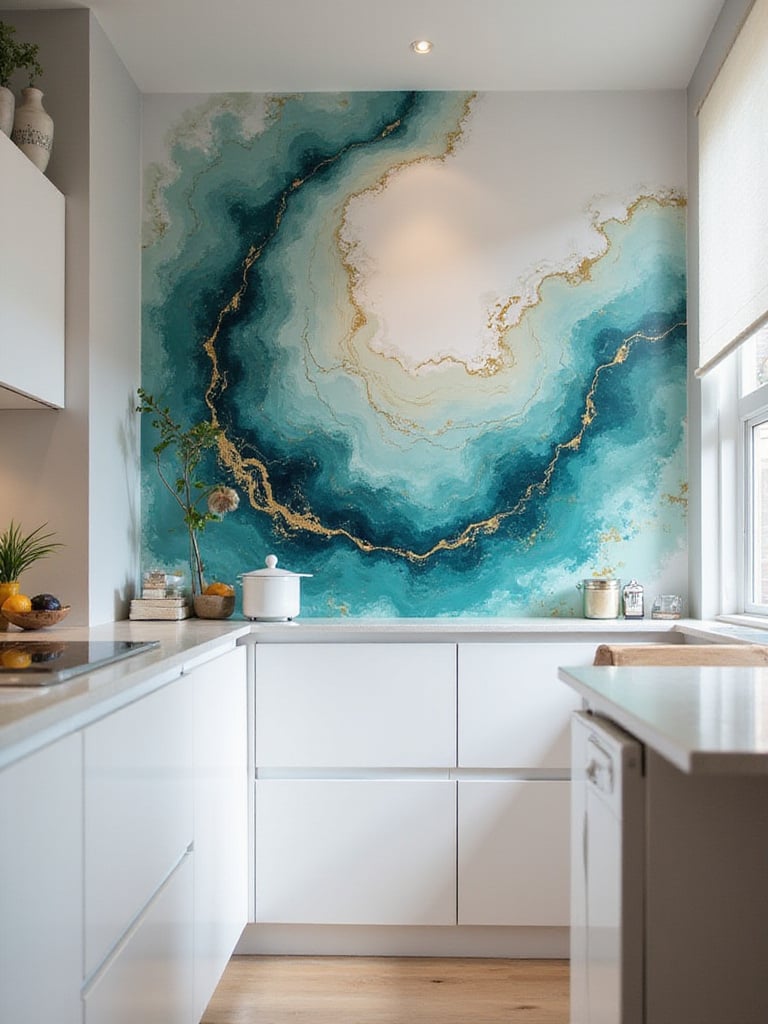
The strength of abstract wallpaper in a cross-cultural home is its flexibility. It can capture the essence of a culture without being limited by its traditional forms. You might find a design with the fluid, energetic brushstrokes of Chinese calligraphy, the bold, dramatic color-blocking of a Mexican mural, or the quiet, meditative tones of a Japanese ink wash painting. These papers create an environment that feels contemporary and deeply rooted at the same time. I had a conversation with Kenji Nakamura, a contemporary artist who explores this very idea, and he said something that stuck with me: “Abstract patterns allow families to honor their cultural aesthetics without being locked into the past. A wallpaper can capture the energy of a traditional dance, the color harmony of a festival, or the emotional memory of an ancestral home.”
To use abstract wallpaper successfully, start by thinking about the feeling you want to evoke. What colors, shapes, and textures resonate with your cultural background and your personal taste?
A few things to explore:
- Cultural Color Stories: Dive into the traditional color palettes of your heritage. Are they the warm earth tones of Southwestern pottery, the vibrant jewel tones of Indian silks, or something else entirely?
- Compositional Principles: Look at the art from your culture. Is there an emphasis on asymmetrical balance, like in Japanese art, or on rhythmic repetition, like in African textiles?
- Emotional Landscapes: Think about what an abstract pattern could represent. The rolling hills of a homeland? The vibrant energy of a city? A feeling of peace or celebration?
From the deeply personal expression of abstract art, we move to the serene and functional philosophy of Scandinavian design.
11. Scandinavian Serenity: Light, Function, and Cultural Mindfulness
Scandinavian-inspired design is so much more than a trend; it’s a philosophy. Rooted in the realities of long, dark winters and short, precious summers, this design tradition is built around maximizing natural light, celebrating humble, natural materials, and creating spaces that are both flawlessly functional and emotionally soothing. When you bring these principles into a multicultural kitchen, you create a calm, sturdy foundation that can beautifully support and showcase a vibrant mix of other cultural elements.

The true genius of Scandinavian design in this context is its role as a perfect, neutral host. It creates a serene backdrop that allows other stories to be told more clearly. Think of light-colored wallpapers with subtle, natural textures—a paper that hints at the delicate grain of birch bark or the soft, nubby weave of linen. These wallpapers don’t compete for attention. Instead, they create a calming atmosphere where your family’s cultural treasures, colorful textiles, and unique cookware can truly pop. This “less is more” approach aligns beautifully with many Eastern design philosophies that also value restraint and purpose. As interior anthropologist Dr. Astrid Johansson points out, “Scandinavian design is fundamentally about creating space for life to happen.” When families from other backgrounds adopt these principles, they often find that their own cultural heirlooms and design elements become more prominent and meaningful, not less.
To bring this into your own kitchen, think beyond just light colors. Consider how light physically moves through your space during the day. How can your wallpaper choice help amplify it? Look into sustainable and natural material options, which is a core value of the Scandinavian ethos.
This idea of finding meaning in past traditions leads us beautifully into the world of vintage patterns, which can be a powerful way to honor your more recent family history.
12. Heritage Revival: Vintage Patterns That Honor Family History
Vintage and retro wallpapers are like time capsules for your wall. They offer a powerful and often deeply personal way to connect with your family’s history and cultural memory. These patterns hold the aesthetic DNA of a specific moment in time—the sunny, optimistic florals of 1950s America, the bold, earthy geometrics of the 1970s cultural shift, or the delicate, Art Nouveau-inspired motifs of turn-of-the-century Europe. When you choose a vintage pattern thoughtfully, it becomes more than just a retro look; it becomes a daily connection to your family’s stories and the world that shaped them.
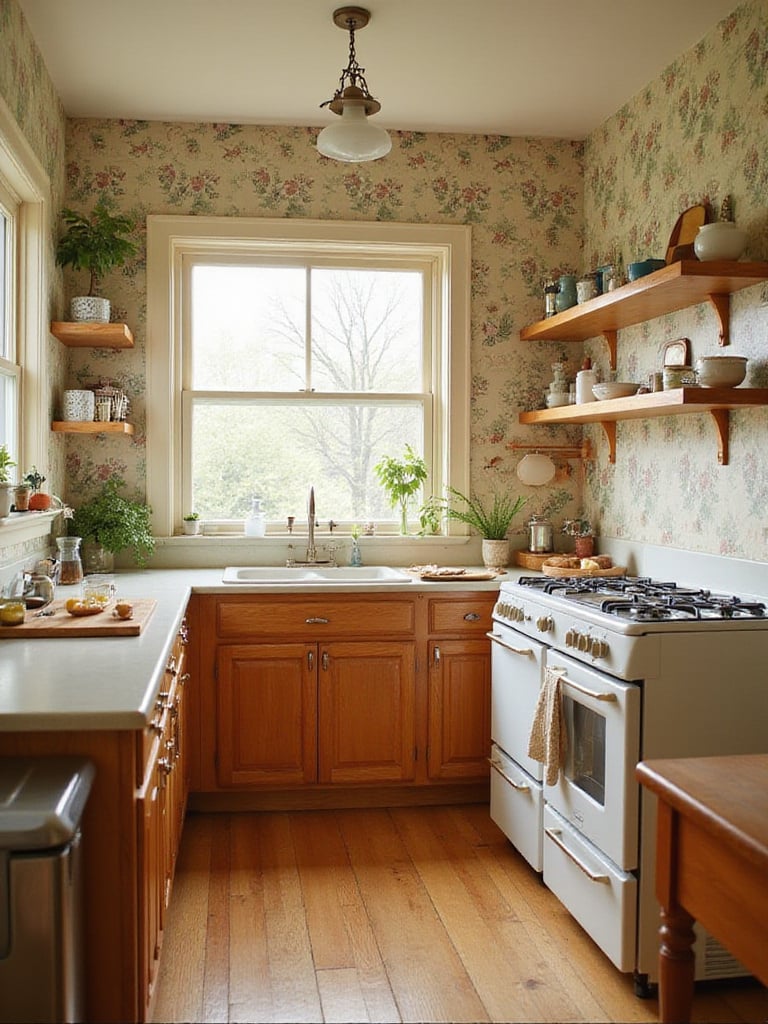
The key to making vintage work in a modern, multicultural kitchen is to understand the context. Why does a particular pattern resonate with you? Maybe you choose a pattern that’s a near-perfect match for the one in your grandmother’s kitchen, creating a direct line to cherished memories. Or perhaps you select a design that reflects a significant cultural movement or historical moment in your family’s immigration story. These choices infuse your kitchen with layers of meaning. Cultural historian Dr. Elena Rodriguez calls these “temporal bridges”—they connect the past to the present, allowing you to honor your history while making new memories. The goal isn’t a perfect historical recreation. It’s about finding a pattern that has authentic cultural resonance for you.
When you’re looking at vintage patterns, do a little research. What was happening in the world when that design was popular? Consider how a vintage aesthetic will dialogue with your modern appliances and other cultural artifacts. Sometimes the contrast is what makes it exciting!
Of course, no matter how beautiful or meaningful the pattern, a kitchen is a workhorse. That means we have to get serious about choosing materials that will last.
13. Material Mastery: Selecting Durable, Washable Papers for Cultural Longevity
This is where the romance of design meets the reality of life. In a kitchen that’s a hub of cultural cooking, choosing a durable, washable wallpaper is absolutely non-negotiable. Different cooking styles create different challenges. The high-heat intensity of wok cooking, the long, steamy simmering of a stew, the fine dust of spice-grinding, the happy chaos of bread-making—all of these activities produce varying amounts of steam, grease, and splashes that can wreak havoc on the wrong material. Choosing the right one means your beautiful, culturally significant wallpaper will stay beautiful for years.
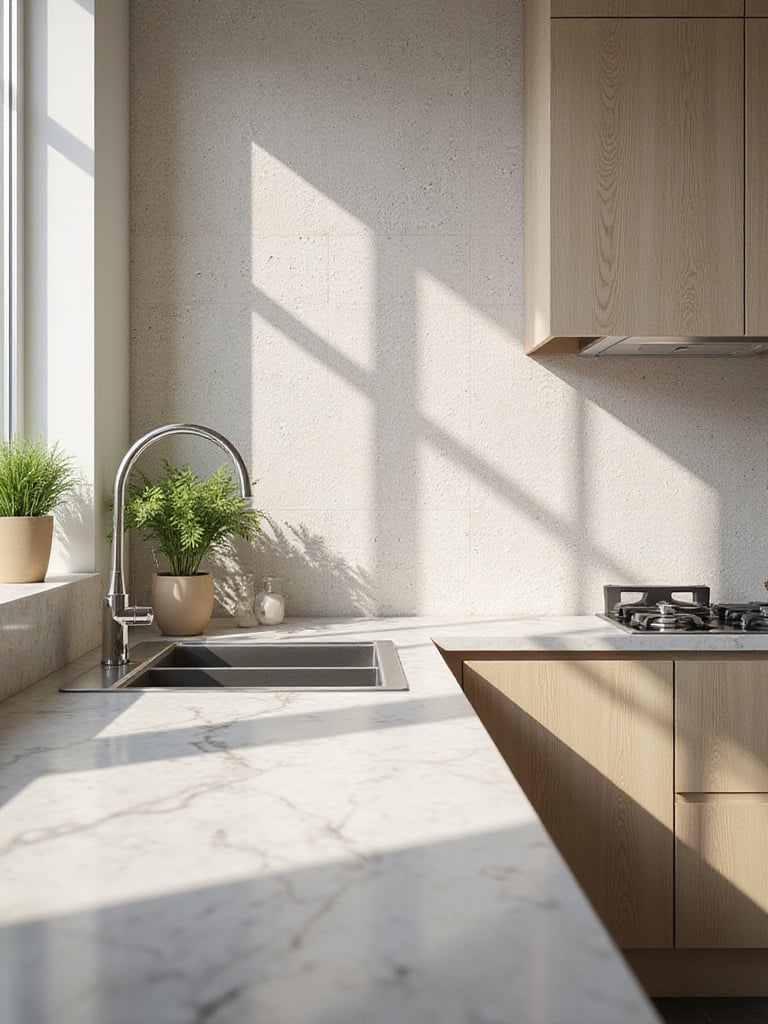
The good news is, wallpaper technology has caught up with our global kitchens. Modern vinyl-coated papers can give you the look of a delicate hand-printed textile but can withstand the humidity from a giant pot of pho or the splatter from a bubbling curry. Non-woven papers offer the sophisticated, matte texture of natural materials but are scrubbable, which is essential in a kitchen where aromatic spices and oils are a part of daily life. I rely heavily on the advice of Carmen Liu, a professional installer who works almost exclusively with multicultural families. She says, “I have to understand how a family cooks. A kitchen where someone is grinding fresh turmeric needs a different kind of durability than one where they’re mostly baking. We have to preserve the story on the wall, but it has to survive the story being made on the stove.”
Be brutally honest with yourself about your cooking habits. What are the biggest challenges in your kitchen? High humidity? Grease? Odors? Look for wallpapers specifically rated for kitchens or even commercial spaces. Research how different materials hold up to the specific demands of your family’s culinary traditions.
This focus on practicality is especially relevant when considering one of the most accessible options on the market today: peel-and-stick wallpaper.
14. Flexible Cultural Expression: Peel-and-Stick Solutions for Evolving Identities
Peel-and-stick wallpapers are, frankly, a game-changer, especially for multicultural families. Why? Because our identities aren’t static. Our connection to our heritage can evolve. Second-generation kids might be exploring their roots for the first time. Partners from different backgrounds might be finding a new aesthetic that blends both of their histories. Peel-and-stick offers the freedom to experiment, to change your mind, to adapt your space as your family’s story unfolds.

This flexibility is incredibly liberating. It removes the fear of permanent commitment that often stops people from making bold cultural statements. You can try out that vibrant pattern you love without worrying you’ll be stuck with it forever. It’s perfect for renters who are barred from making permanent changes. You can even use it for temporary installations—imagine putting up a specific pattern to honor a cultural holiday or festival and then taking it down afterward. Design accessibility advocate Dr. Priya Sharma notes how this technology has democratized cultural expression. It lowers the financial and emotional barriers, allowing for a more authentic, playful, and personal exploration of design.
To get the most out of peel-and-stick, preparation is still key. Make sure your walls are perfectly clean and smooth. And manage your expectations. Research products that are specifically designed for the higher humidity of a kitchen environment, as they’ll have better adhesion and be easier to clean than general-purpose options.
Whether you choose traditional or peel-and-stick, a smart approach involves thinking about your kitchen in zones, each with its own environmental challenges.
15. Zone-Specific Protection: Heat and Moisture Resistance for Cultural Cooking
A kitchen isn’t one single environment; it’s a collection of micro-climates. And if your cooking is rooted in specific cultural traditions, those micro-climates can be extreme. The area behind your stovetop is a world away from the wall behind your breakfast table. Thinking in zones is the key to making your wallpaper last. The intense, sputtering heat from Asian-style stir-frying requires a different kind of protection than the gentle, consistent steam from a slow-cooked Mediterranean braise.
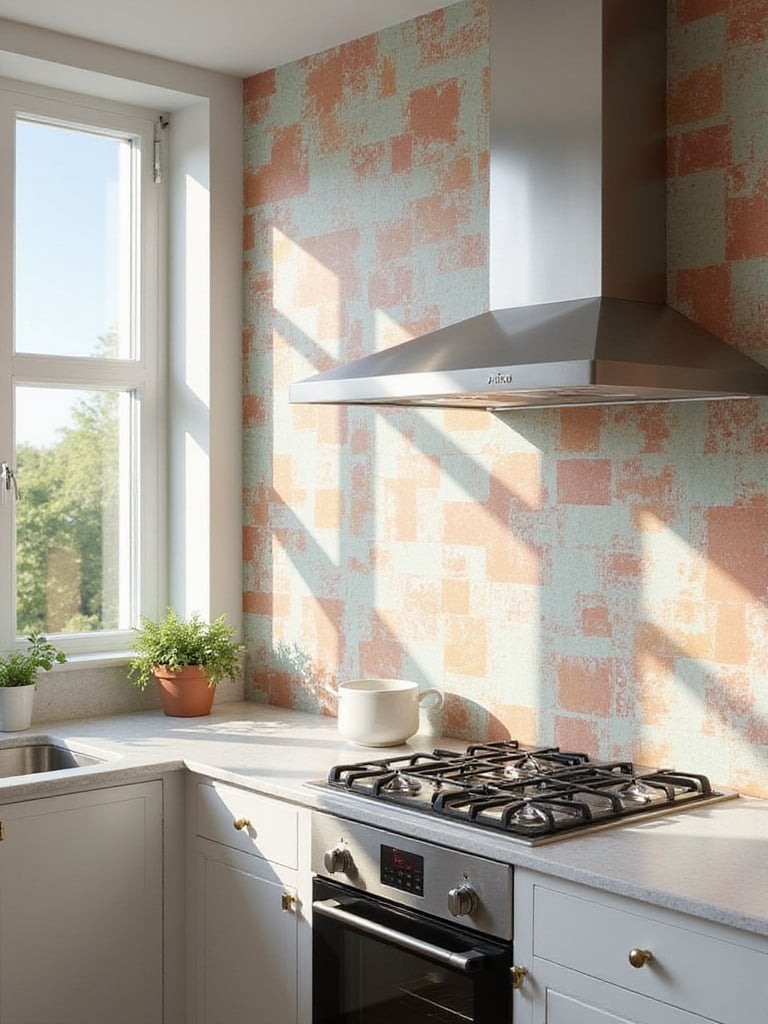
The goal is to match the material to the task. The wall behind your range, for example, is your kitchen’s hot zone. It needs a wallpaper rated for high heat and temperature fluctuations. The area around your sink, dishwasher, and maybe your rice cooker is the moisture zone. Here, you’ll want something with a moisture barrier and perhaps even antimicrobial properties to prevent mildew. Then there are the aromatic zones—the places where you grind spices or chop lots of garlic and onions. Here, a non-porous surface that won’t absorb odors is your best bet. A colleague of mine, Ahmed Hassan, who designs kitchens for diverse communities, says he thinks about the “environmental signature” of each cooking style—how heat, steam, and smells travel. This allows him to choose materials that support authentic cooking, so a family never has to change their traditions to protect their décor.
So, take a moment and map out your own kitchen’s signature. Where are the areas of highest stress? Get specific about how your cultural cooking habits differ from the “standard” Western kitchen model that many products are designed for.
Here’s a quick-hit list:
- High-Heat Zones: Behind ranges and cooktops. Look for heat-resistant ratings.
- High-Moisture Areas: Around sinks and prep areas. Look for vapor barriers and washability.
- Aromatic Protection: Near spice-grinding or food prep stations. Look for non-porous, scrubbable surfaces.
Once you’ve chosen the right paper for the right zone, the success of the project hinges on one crucial, often-overlooked step: preparation.
16. Cultural Preparation Rituals: Creating the Perfect Foundation
When you’re hanging a wallpaper that holds deep cultural significance, preparing the wall is more than just a chore. It’s the first step in honoring that tradition. I like to think of it as a ritual. It’s a moment to slow down and create a flawless foundation, ensuring that the pattern you’ve chosen so carefully will look its best and last for years. This is the unseen work that makes all the difference.

There’s a deep respect embedded in this process. Just as a traditional artisan would never begin their work on a poorly prepared canvas, you should approach your walls with that same sense of care. It’s about respecting the materials, the pattern, and the story it tells. Master craftsman Roberto Martinez, who teaches traditional building arts, once told me, “Preparation is where respect begins. When you take the time to do it right, you’re participating in the same mindful approach that artisans have used for centuries.” That mindfulness not only leads to a better technical result, but it also deepens your own connection to the design.
Practically, this means not cutting corners. Clean the walls thoroughly to remove any grease. Fill every crack and sand every bump until the surface is perfectly smooth. Use a quality wallpaper primer, which helps the paper adhere properly and also makes it easier to remove down the road. Every step, done with patience and precision, contributes to a final result that feels truly worthy of its cultural importance.
With your canvas perfectly prepped, you face a big decision: do you take on the installation yourself, or do you call in a professional?
17. Honoring Craftsmanship: Professional vs. DIY Cultural Installation
The decision between hiring a professional installer and doing it yourself becomes more complex when the wallpaper isn’t just a pattern, but a piece of your heritage. This choice is a balance of your budget, your skills, your patience, and your desire for a result that truly honors the design tradition you’ve chosen. There’s no single right answer, but it’s a decision to be made thoughtfully.
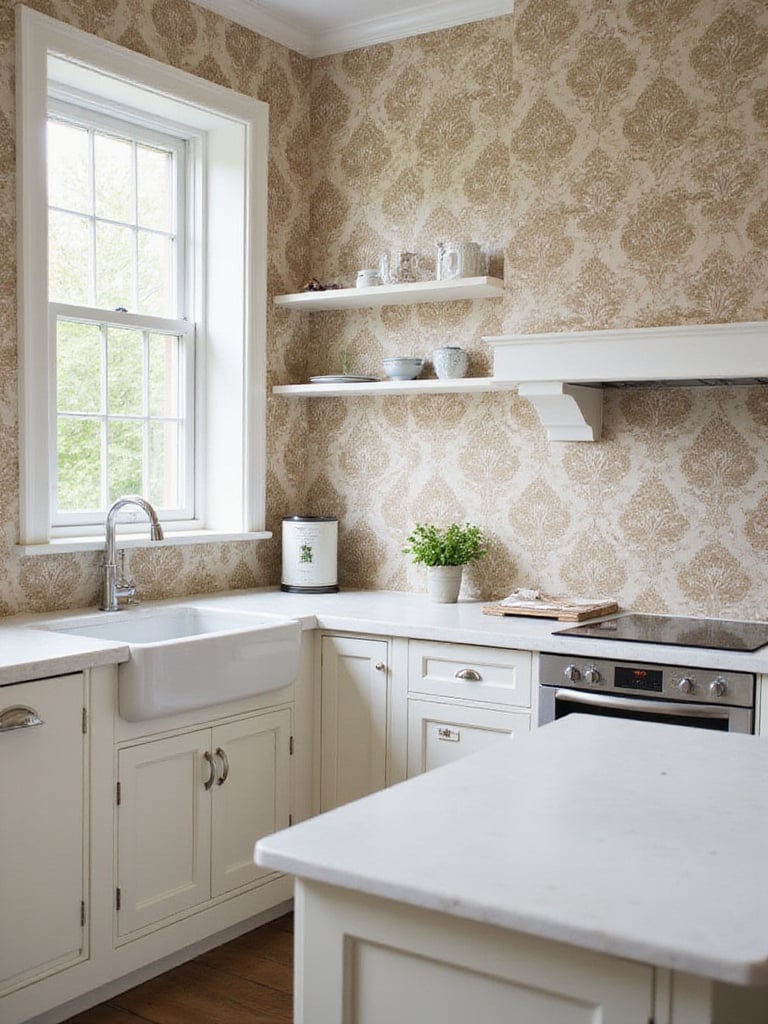
Here’s where a pro is often worth their weight in gold: with papers that require specialized knowledge. Think of hand-printed papers where the pattern has slight variations, natural grasscloths that can stain if you get paste on the front, or intricate geometric patterns where a slight misalignment would throw off the entire design. A seasoned installer who understands these materials can be the difference between a masterpiece and a mess. However, this doesn’t mean DIY is a bad option. A careful, patient DIY-er who has done their research can absolutely achieve a beautiful result. I’ve seen DIY installations that were filled with so much love and respect for the culture that they felt more authentic than some technically perfect professional jobs that missed the “why.” Dr. Lin Zhang, a cultural arts educator, said it best: “The most important factor isn’t pro versus DIY. It’s the level of care and respect brought to the work.”
To make your choice, be honest with yourself. How complex is the pattern? Does it require precise matching? How much does absolute perfection matter to you? And most importantly, do you have the patience for a detailed, sometimes frustrating, process? If the idea of making a mistake on a meaningful—and potentially expensive—roll of paper fills you with dread, it might be worth the investment to hire a pro.
One of the biggest challenges, whether you DIY or hire it out, is mastering the art of the perfect pattern match.
18. Precision as Cultural Respect: Mastering Pattern Alignment Across Traditions
Getting the pattern to line up perfectly is more than just a technical skill. When you’re working with culturally significant designs, that precision becomes an act of respect. It’s about honoring the mathematical genius in an Islamic geometric, the flowing natural rhythm of an Art Nouveau floral, or the balanced asymmetry of a Japanese motif. When you achieve that perfect alignment, you’re not just making it look good; you’re engaging in a dialogue with the centuries of artistic wisdom that created it.
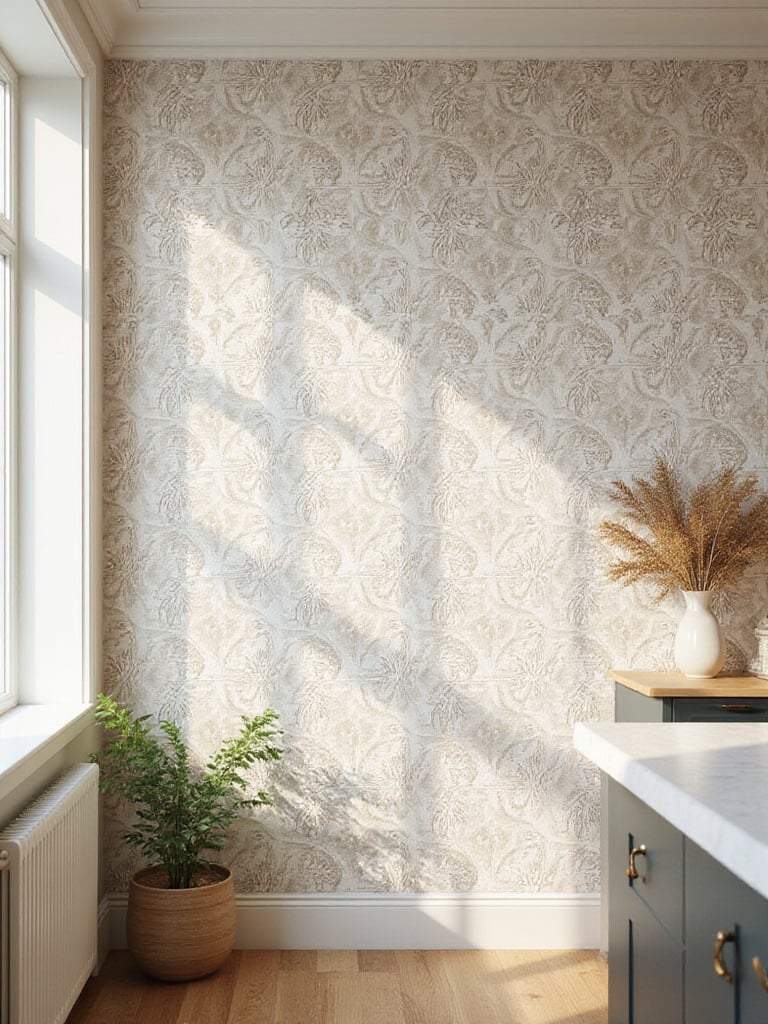
Think about it this way: many traditional patterns have deep mathematical or spiritual principles woven into their design. When they are misaligned, that inner logic is broken. The harmony is lost. It can inadvertently feel careless or even disrespectful to the tradition you’re trying to celebrate. I’ll never forget a consultation where a family had attempted to install a beautiful Islamic star pattern themselves. The slight misalignments at the seams disrupted the pattern’s sense of infinite repetition, which is core to its spiritual meaning. It was a small technical error, but it changed the entire feel of the design. Fatima Al-Rashid, a master pattern maker, emphasizes this point: “When we compromise on precision, we can lose the cultural essence that makes these designs meaningful, and they just become decorative.”
So, whether you’re doing it yourself or discussing it with your installer, focus on this. Understand the “repeat” of your pattern. Take the time to meticulously plan where your seams will fall. Start in the most visible corner and work your way out. This careful attention to detail is what will elevate your project from simply decorated to truly honoring.
This idea of honoring a pattern is especially crucial when you decide to go big and create a single, stunning accent wall.
19. Cultural Focal Points: Creating Meaningful Accent Walls
Using a culturally significant wallpaper to create an accent wall is a powerful move. It’s a way to make a bold, unapologetic statement about your heritage. But it requires a thoughtful approach. You’re not just creating a focal point; you’re creating a cultural focal point. This means balancing the desire for high drama with a respectful understanding of how different traditions use emphasis and visual weight.
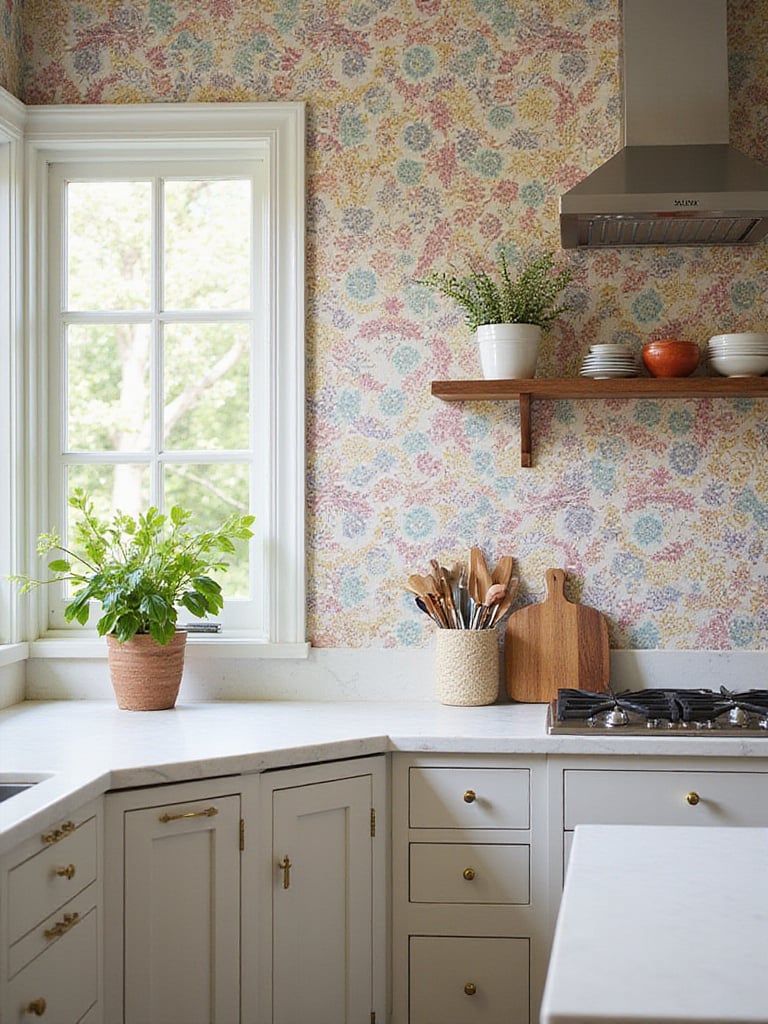
The very concept of a single “accent wall” is quite Western. In many other design philosophies, visual interest is distributed more evenly throughout a space. So, the first step is to consider whether a bold, singular statement feels authentic to the tradition you’re representing and to your family’s story. If it does, fantastic. If not, you might consider a more subtle approach, like papering two opposing walls instead of just one. The most successful cultural accent walls I’ve seen are more than just pretty backdrops; they become spaces for storytelling and conversation. Dr. Maya Patel, a cultural space designer, advises thinking of it as curating a gallery wall—it needs to have impact, but it also needs to invite people in and tell them something meaningful.
To create an effective accent wall, think about its role in your kitchen’s daily life. Will it be the backdrop for family meals? Will it be the first thing guests see? The answers will help you choose not only the right pattern but also the right wall. You want to place your cultural story where it will be seen, appreciated, and integrated into the life of your home.
Often, that accent wall will have to coexist with a very practical element: the backsplash. This creates another opportunity for beautiful cultural dialogue.
20. Material Harmony: Coordinating Wallpaper with Diverse Backsplash Traditions
The space where your wallpaper meets your backsplash is a critical design moment. It’s a chance to create a beautiful conversation between different materials, patterns, and cultural stories. This gets especially interesting in multicultural kitchens, where you might have a backsplash that speaks to one side of the family’s heritage and a wallpaper that honors another. The goal is to make these two elements feel like they’re in a harmonious partnership, not a competition.
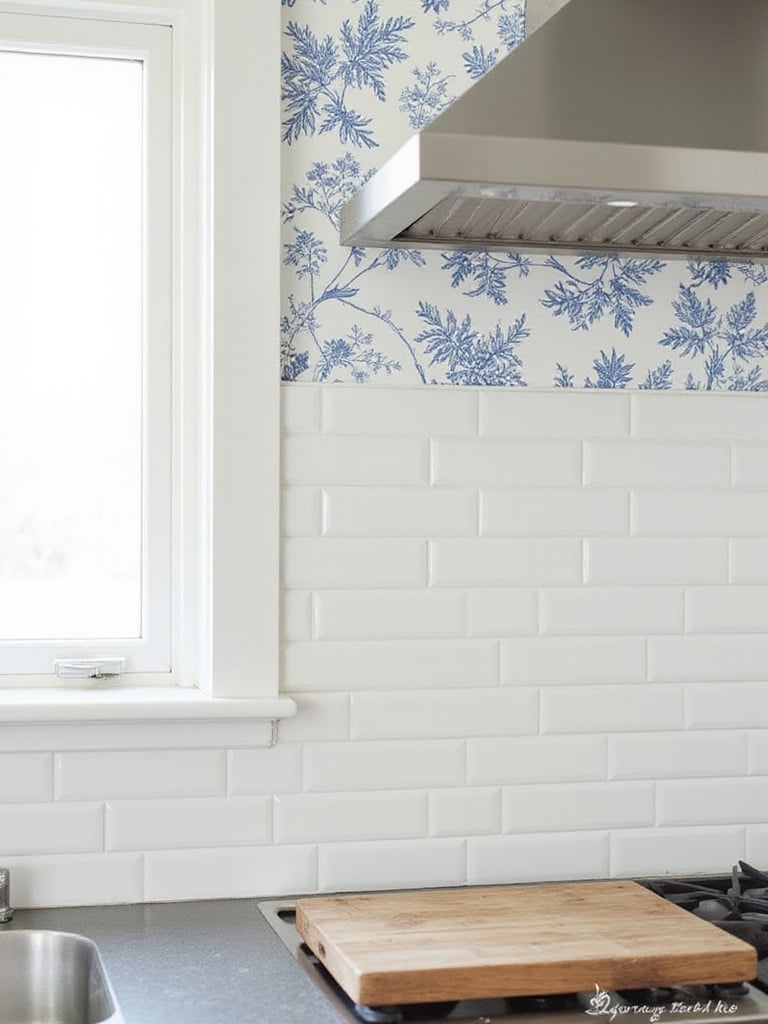
The art of this coordination is finding the “shared DNA.” What do the two materials have in common? It might not be obvious at first. A vibrant, hand-painted Moroccan tile backsplash and a subtle, Scandinavian-inspired botanical wallpaper might seem like an odd couple. But maybe they share a specific shade of blue. Or maybe the handmade quality of the tiles is echoed in the organic, hand-drawn feel of the wallpaper pattern. You’re looking for a bridge. Interior design anthropologist Dr. Carlos Mendez talks about these “unlikely but harmonious” pairings. A Japanese-style tile and a Swedish-influenced wallpaper, he notes, can work beautifully together because both traditions value natural materials, subtlety, and functional beauty.
To make this work, analyze the cultural and aesthetic character of your backsplash. Is it glossy or matte? Warm or cool-toned? Ornate or simple? Then look for a wallpaper that can either complement it or offer a pleasing contrast. Sometimes a simple, textured wallpaper is the perfect quiet partner to a busy, patterned tile. Other times, a bold wallpaper can make a plain subway tile backsplash feel much more special.
Don’t forget that wallpaper isn’t just for walls. Some of the most personal cultural stories can be told in the most unexpected places.
21. Hidden Cultural Stories: Creative Applications Beyond Traditional Walls
Some of the most meaningful design moments are the ones you discover. Using wallpaper in unexpected places—lining the inside of your glass-front cabinets, wrapping your kitchen island, papering the back of your open shelves, or creating a surprise in your pantry—allows you to weave in subtle, intimate cultural details that reward a closer look. This approach is perfect for those who want to honor their heritage without putting it all on display, or for whom cultural identity feels more personal and quiet than bold and celebratory.
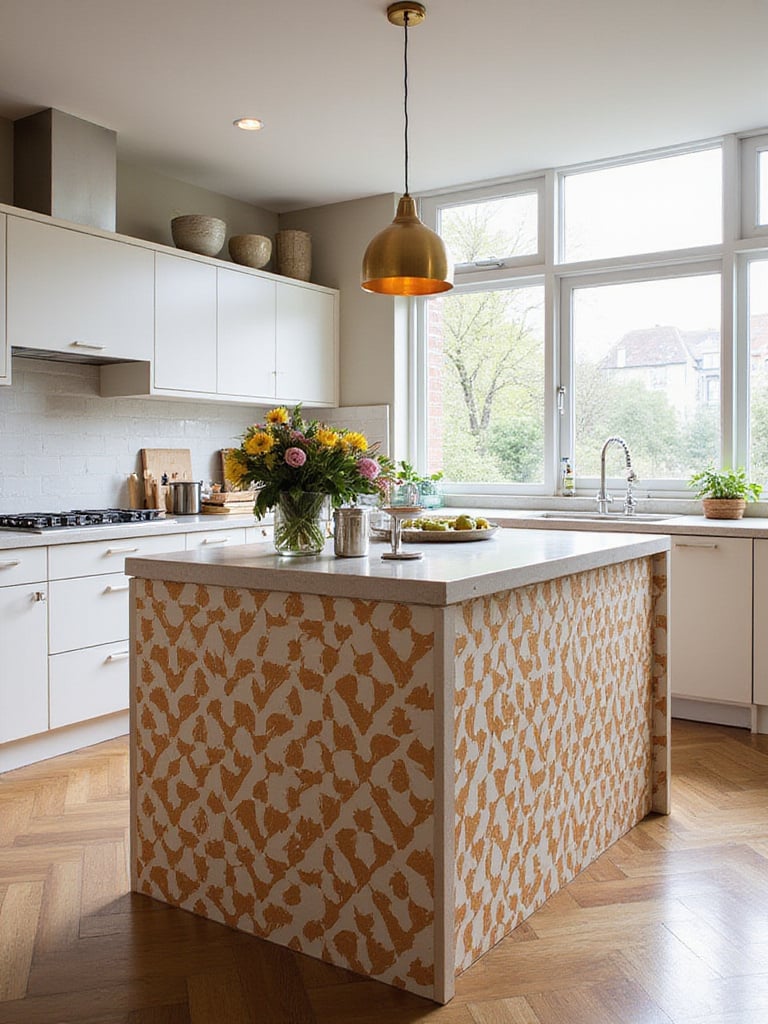
The power of these hidden stories lies in their intimacy. It’s a private moment of connection. Imagine opening a cabinet every morning to get a coffee mug and seeing a pattern that reminds you of your grandmother’s favorite dress. Or preparing a meal at an island wrapped in a paper that echoes the architectural details of your ancestral homeland. These aren’t loud statements; they are quiet whispers of identity integrated into the fabric of your daily routine. Cultural memory specialist Dr. Amara Hassan explains that these subtle applications often become the most cherished because they create an ongoing, private dialogue with your heritage.
To do this successfully, think about the places in your kitchen that are part of your personal rituals. The inside of your tea cabinet? The wall next to where you knead dough? Consider the durability of the paper for these high-touch areas. A vinyl or peel-and-stick option might be best for the side of an island that gets kicked, while a more delicate paper could be protected behind glass cabinet doors.
Finally, after all this work, you’ll want to ensure that the beauty—and the story—of your wallpaper lasts for years to come.
22. Preserving Cultural Beauty: Maintenance Techniques for Lasting Heritage
Caring for a culturally significant wallpaper is an act of ongoing stewardship. It’s about more than just cleaning; it’s about showing continued respect for the traditions, the artistry, and the family stories that your wallpaper represents. Proper maintenance ensures that this visual connection to your heritage remains a vibrant part of your home, not a faded memory.

Think of it like caring for any other cultural artifact, like a hand-woven textile or a piece of traditional pottery. You wouldn’t scrub an heirloom with a harsh chemical, and the same principle applies here. Your approach should be guided by the material itself. A durable vinyl can handle a gentle wipe-down with a damp sponge. A delicate, hand-printed paper might only be suitable for gentle dusting. A natural grasscloth could be ruined by water. Dr. Elena Vasquez, a conservation expert, puts it this way: “When families understand they’re caring for more than just decoration—that they’re preserving a piece of their identity—they naturally become more mindful and gentle. This preserves both the life and the meaning of the design.”
The best maintenance plan starts the day of installation. Keep a record of the manufacturer and the specific material so you can look up their care recommendations. Be mindful of environmental factors—does the afternoon sun beat down on one wall? Is your kitchen well-ventilated to handle cooking steam? A little prevention goes a long way in preserving the beauty and significance of your investment.
Here’s a simple framework:
- Material-Specific Care: Know your paper. Research the correct cleaning methods for vinyl, non-woven, grasscloth, or hand-printed materials.
- A Preservation Mindset: Treat maintenance like you’re caring for an important family artifact, not just scrubbing a wall.
- Preventive Protection: Think about humidity, sunlight, and ventilation to protect your wallpaper from the get-go.
Conclusion
This journey through the world of kitchen wallpaper reveals its incredible power to do more than just decorate. A thoughtfully chosen wallpaper can transform your kitchen into the true heart of your home—a space that honors your heritage while embracing your contemporary life. We’ve seen how these patterns can tell stories, connect us to our roots, and create daily moments of cultural connection. Whether you’re drawn to the meditative geometry of an Islamic pattern, the wild beauty of a botanical print, or the serene simplicity of a Scandinavian design, the right wallpaper can make your kitchen feel both globally inspired and deeply, authentically personal.
The practical side of things—the material choices, the careful installation, the zone-specific planning—is what ensures your beautiful vision will last. Remember to approach this process with patience and with respect, both for the materials you’re using and for the traditions they represent. The investment you make in quality, preparation, and thoughtful execution will pay you back every single day in a kitchen that you love not just for how it looks, but for the story it tells.
Your kitchen deserves to be a canvas for your life. It should reflect your family’s memories, your cultural journey, and your aesthetic joy. The ideas we’ve explored here are your starting point. Begin by gathering samples that speak to you. Live with them in your space. And approach the project with the care that such a meaningful transformation deserves. Your new kitchen is waiting to tell its story. Your story.






